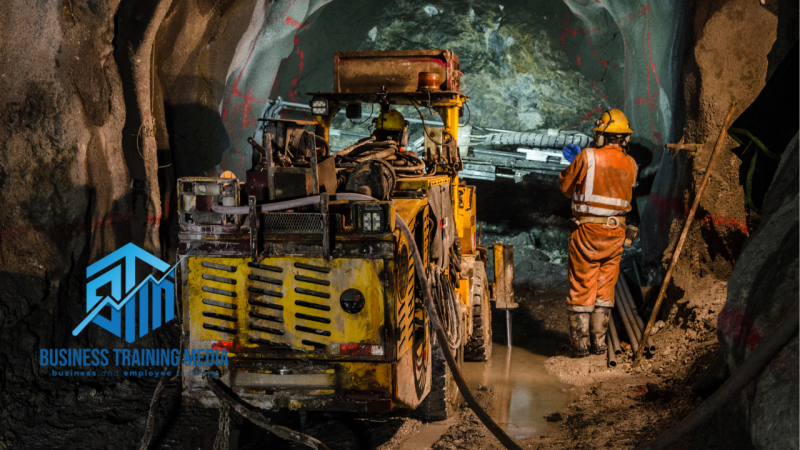
Ensuring Mine Safety: Comprehensive Training for Employees
By Business Training Media
Safety is of paramount importance in any industry, but it holds particular significance in the mining sector. The nature of mining operations exposes workers to numerous risks, making it crucial for companies to prioritize comprehensive safety training for their employees. By equipping workers with the knowledge and skills to identify and mitigate potential hazards, mine safety training plays a pivotal role in preventing accidents, injuries, and fatalities. This article delves into the importance of mine safety training and highlights key elements that contribute to effective employee training programs.
Understanding the Importance of Mine Safety Training:
- Prevention of Accidents: Mining environments are inherently hazardous, with potential risks such as cave-ins, explosions, equipment failures, and exposure to toxic gases. Safety training empowers employees to identify potential hazards, assess risks, and implement preventive measures, significantly reducing the occurrence of accidents.
- Health and Well-being: Mining activities often expose workers to various occupational health risks, such as respiratory diseases, hearing loss, and musculoskeletal disorders. Safety training educates employees about the proper use of personal protective equipment (PPE), safe handling of chemicals, and adherence to health protocols, safeguarding their well-being.
- Legal Compliance: Governments worldwide enforce stringent regulations to ensure mine safety. Adequate safety training helps companies comply with these regulations and avoid penalties or legal consequences. Moreover, a commitment to safety fosters a positive corporate image and attracts socially responsible investors.
Key Elements of Effective Mine Safety Training:
- Comprehensive Risk Assessment: Before designing a training program, companies must conduct a thorough risk assessment of their mining operations. This evaluation should identify potential hazards, evaluate their severity and likelihood, and prioritize areas for training focus. By customizing training to address specific risks, companies can enhance the effectiveness of their programs.
- Regulatory Compliance: An effective training program should encompass all legal requirements and standards relevant to the mining industry. This includes training on Occupational Safety and Health Administration (OSHA) guidelines, mine-specific regulations, and any additional industry-specific requirements. Compliance training ensures employees are aware of the standards they must follow to maintain a safe working environment.
- Hazard Recognition and Control: Employees should be trained to identify potential hazards and implement appropriate control measures. Training sessions should cover topics such as recognizing unstable ground conditions, electrical safety, equipment operation protocols, and emergency response procedures. Providing employees with practical skills and knowledge equips them to take proactive measures to minimize risks.
- Emergency Preparedness: Mining operations can face emergencies such as fires, floods, or underground collapses. Training programs should include emergency response training, covering evacuation procedures, first aid techniques, communication protocols, and the use of safety equipment. Regular drills and simulations can reinforce preparedness and enhance the ability of employees to respond effectively in crisis situations.
- Behavioral Training: Promoting a safety-conscious culture is as vital as technical training. Employees should receive behavioral training that emphasizes the importance of personal accountability, adherence to safety protocols, and effective communication. Encouraging reporting of near misses and incidents without fear of reprisal fosters a culture of continuous improvement and proactive hazard identification.
- Ongoing Education and Refreshers: Safety training should not be a one-time event. Regular refreshers and ongoing education ensure employees stay updated on the latest safety practices, technologies, and regulations. Periodic assessments and evaluations can identify areas for improvement and support the continuous development of a safety-conscious workforce.
Mine safety training is indispensable for ensuring the well-being of employees in the mining industry. By investing in comprehensive training programs, mining companies can reduce accidents, protect employees' health, comply with regulations, and promote a culture of safety. The integration of risk assessment, regulatory compliance, hazard recognition, emergency preparedness, behavioral training, and ongoing education are key components that contribute to effective
Looking for online mine safety training? If so, check out Compliance Training Online for a huge selection of mine safety training courses.
© Copyright 2023 - Business Training Media, Inc.
About the Publisher: Business Training Media
Business Training Media is a global provider of training videos and online courses for employees, managers, supervisors, and students. The company has provided training solutions to over 22,000 organizations worldwide from start-ups to high-profile companies like American Express, IBM, 3M, FedEx, American Honda, Cisco, Verizon, Microsoft, AT&T, Bank of America, Google, and thousands of others.




